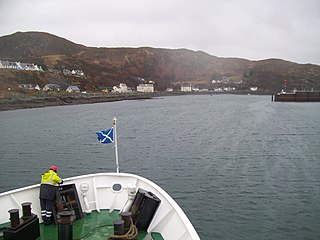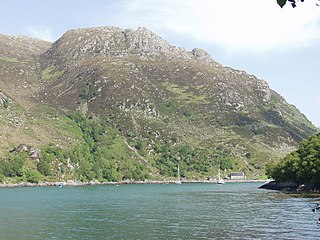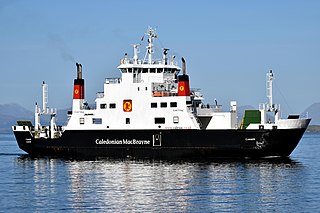
The Small Isles are a small archipelago of islands in the Inner Hebrides, off the west coast of Scotland. They lie south of Skye and north of Mull and Ardnamurchan – the most westerly point of mainland Scotland.

Knoydart is a peninsula in Lochaber, Highland, on the west coast of Scotland. Knoydart is sandwiched between Lochs Nevis and Hourn — often translated as "Loch Heaven" and "Loch Hell" respectively, although the somewhat poetic nature of these derivations is disputed. Forming the northern part of what is traditionally known as na Garbh-Chrìochan or "the Rough Bounds", because of its harsh terrain and remoteness, Knoydart is also referred to as "Britain's last wilderness". It is only accessible by boat, or by a 16-mile (26 km) walk through rough country, and the seven miles (11 km) of tarred road are not connected to the UK road system.

Caledonian MacBrayne, usually shortened to CalMac, is the major operator of passenger and vehicle ferries, and ferry services, between the mainland of Scotland and 22 of the major islands on Scotland's west coast. Since 2006 the company's official name has been CalMac Ferries Ltd although it still operates as Caledonian MacBrayne. In 2006 it also became a subsidiary of holding company David MacBrayne, which is owned by the Scottish Government.

Mallaig is a port in Lochaber, on the west coast of the Highlands of Scotland. The local railway station, Mallaig, is the terminus of the West Highland railway line and the town is linked to Fort William by the A830 road – the "Road to the Isles".

The A830, also known as the Road to the Isles is a major road in Lochaber, Scottish Highlands. It connects the town of Fort William to the port of Mallaig.

Inverie is the main village on the Knoydart peninsula in the Scottish Highlands. It is located on the north side of Loch Nevis and, although on the mainland of Britain, the network of single-track roads surrounding the village is not connected to the rest of the road network. Inverie is only reachable by a 17-mile (27-kilometre) hike over mountainous terrain or by a regular 7 mi (11 km) ferry from Mallaig. This physical isolation gives the village a Guinness National Record for remoteness within the United Kingdom.

Mallaig railway station is a Category C listed railway station serving the ferry port of Mallaig, Lochaber, in the Highland region of Scotland. This station is a terminus on the West Highland Line, 41 miles (66 km) by rail from Fort William and 164 miles (264 km) from Glasgow Queen Street.

The Caledonian MacBrayne fleet is the largest fleet of car and passenger ferries in the United Kingdom, with 34 units in operation and another 2 under construction. The company provides lifeline services to 23 islands off the west coast of Scotland, as well as operating routes in the Firth of Clyde.

MV Lord of the Isles is one of the larger Caledonian Maritime Assets Limited ferries, run by Caledonian MacBrayne and largely operating from Mallaig on the west of Scotland. Built in Port Glasgow, she is the most-travelled vessel in the CalMac fleet.

Tarbet is a place on the south shore of Loch Nevis in Scotland, about 6 miles east of Mallaig. The name 'tarbet' refers to a portage or isthmus, in this case it is between Loch Nevis and Loch Morar.

MV Loch Fyne is a Caledonian MacBrayne car ferry, owned by Caledonian Maritime Assets Limited, built in 1991 for the Isle of Skye crossing and now operating the Mallaig to Armadale route in western Scotland.

MV Lochnevis is a Caledonian Maritime Assets ferry, launched in 2000. She is operated by Caledonian MacBrayne, serving the Small Isles of Scotland.

MV Pioneer is a stern / side loading ferry built in 1974, in service for 29 years covering nearly all of Caledonian MacBrayne's routes. She now serves the islands of São Tomé and Príncipe in the Gulf of Guinea and was chartered to rescue Liberian refugees.

MV Loch Bhrusda is a Caledonian Maritime Assets Limited water-jet propulsion ro-ro car ferry operated by Caledonian MacBrayne. After 11 years operating in the Outer Hebrides, she is now a Clyde-based relief small vessel.

MV Coruisk is a Caledonian Maritime Assets Limited ferry built in 2003, operated by Scottish ferry operator Caledonian MacBrayne and serving the west coast of Scotland.
The Sound of Sleat is a narrow sea channel off the western coast of Scotland. It divides the Sleat peninsula on the south-east side of the Isle of Skye from Morar, Knoydart and Glenelg on the Scottish mainland.

MV Lochmor was a ferry operated by Caledonian MacBrayne serving the Small Isles from 1979 until 2001. Since 2009 she has operated cruises from Poole as MV Jurassic Scene.

David MacBrayne is a limited company owned by the Scottish Government. Formed in 1851 as the private shipping company David Hutcheson & Co. with three partners, David Hutcheson, Alexander Hutcheson and David MacBrayne, it passed in 1878 to David MacBrayne.
Caledonian Maritime Assets Limited owns the ferries, ports, harbours and infrastructure for the ferry services serving the west coast of Scotland, the Firth of Clyde and the Northern Isles.

MV Lochinvar is a pioneering diesel electric hybrid ferry built for Caledonian MacBrayne. Initially, she operated between Tarbert and Portavadie, was moved to the Mallaig to Armadale route in 2016 and currently operates on the Lochaline to Fishnish route. She is one of only three passenger and vehicle roll-on, roll-off ferries in the world to incorporate a low-carbon hybrid system of diesel electric and lithium ion battery power and is the second hybrid ferry commissioned and owned by Caledonian Maritime Assets. The ferries are sea-going and are 43.5 m (143 ft) long, accommodating 150 passengers, 23 cars or two HGVs. The first ferry, MV Hallaig, entered service on the Sconser to Raasay route in October 2013. The third sister ship, MV Catriona, entered service in 2016.



















